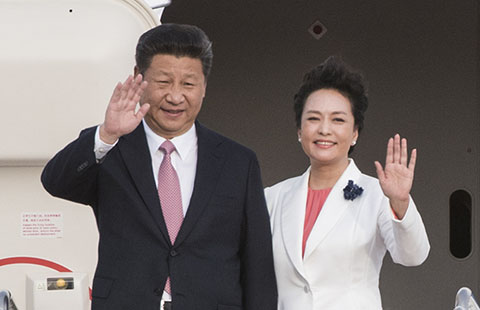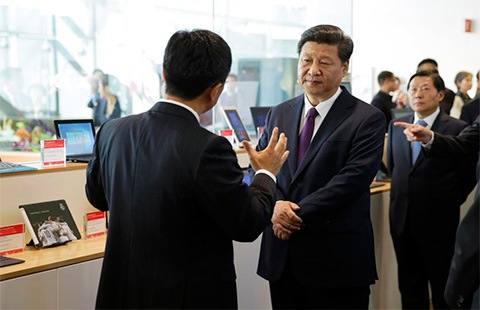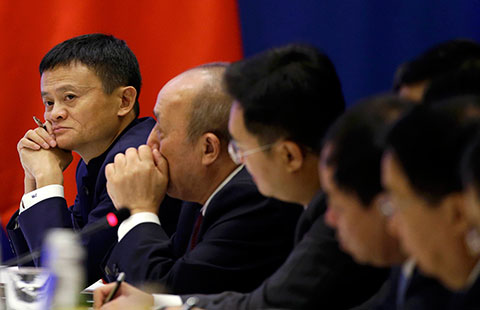Chinese immigration to US a win/win
Updated: 2015-09-25 13:50
By Charles C. Foster(China Daily USA)
|
||||||||
It is no exaggeration that Chinese immigration to the US has played a significant role in our mutual history. Starting with Chinese labor coming to California to provide labor for the 1848 California Gold Rush to Chinese investors immigrating to the US today through EB-5 Regional Center investments, Chinese immigrants have become an important thread in the fabric that makes America.
As our Chinese friends know, the Chinese character for "America," means "beautiful country." America has been a magnet for significant Chinese immigration to the United States at different stages in our histories beginning with the California Gold Rush of 1848-1853 and later on the constructions of the transcontinental railroad.
It came to an end when Congress enacted the Chinese Exclusion Act in 1882, clearly racist legislation. It remained on the books until President Franklin Roosevelt, at the request of President Chiang Kai-Shek of the Republic of China and to maintain China as part of the Big Four war effort against Nazi Germany and Imperialist Japan, urged Congress to repeal same with the passing of the 1943 Magnuson Act.
For decades President George H.W. Bush has said that China is our most important bilateral relation. The historic visit of President Richard M. Nixon and his National Security Advisor, Henry Kissinger to Beijing in February 1972 set the stage for today's economic and political relations, but also a renewal of a significant Chinese immigration to the United States.
Chinese immigration to the US after World War II remained anemic given our 1923 quota system based upon the National Origin Act, which was heavily weighted in favor of northern Europeans with China only being given the minimum 105 annual visa numbers. The door to China did not begin to reopen until President John F. Kennedy proposed and President Lyndon B. Johnson enacted the Immigration and Nationality Act of 1965 abolishing the National Origins Act and establishing worldwide quotas based upon family reunification and job skills.
It was not anticipated that the '65 legislation would dramatically change the make-up of immigration to America given the fact there were very few Chinese Americans that had immediate family members residing in China. But when the US with the greatest higher education institutions opened our doors to the most populated country in the world, China sent bright Chinese students in ever increasing numbers to study in the best US universities.
As the paramount leader of China, Deng Xiaoping reformed and opened the Chinese economy, these bright Chinese graduates of US universities qualified for immigrant status in the US and through their US employers, helped facilitate US corporations' entry into the developing Chinese market. Today there are over 275,000 Chinese students studying in the US, far more than from any other country.
As a result, immigration from Asia in general and particularly from China has transformed America. We now have new modern day China Towns based upon Chinese immigration, investments and entrepreneurial skills. This new wave of Chinese immigration has not only stimulated new economic growth, but has an increasing impact on American politics as Asian Americans represent the fastest growing voter demographic as well.
On the China side there has been little restriction on outbound emigration. As we established diplomatic relations in 1979, the United States considered whether the Jackson-Vanik Amendments to the Trade Act of 1974, which required the US to impose trade restrictions on any country that restricted emigration, applied to China as it did to the Soviet Union. However, during the historic 1979 visit of paramount leader Deng Xiaoping to the United States, when he was asked by then President Jimmy Carter about Chinese restrictions on outbound emigration, Deng Xiaoping's reported response was "How many millions do you want?" Thereafter, the United States showed little or no interest in Chinese emigration policy.
Over the years, given large scale legal Chinese immigration to the United States, significant backlogs have developed under the 2nd and 3rd employment-based preferences and under the family preference. A new and viable option for Chinese immigration opened when Congress in 1990 first established an immigrant preference for investors who created at least 10 jobs for US workers and made a minimum investment of $1 Million, or only $500,000 if they invested in a Targeted Employment Area (TEA) typically through an EB-5 Regional Center.
The annual quota of 10,000 had never been reached for Chinese nationals until May 2015 when for the first time the US State Department established a priority date creating a 2 year plus backlog under the quota for those individuals qualifying by investing in an EB-5 Regional Center.
Perfect conditions were created to increase the numbers of wealthy Chinese immigrating to the US through investment under the EB-5 investment preference classification by the combination of our 2008/2009 great recession and the rise of the Chinese economy. The enactment of the Dodd-Frank Act financial reforms after the US recession caused US real estate developers to seek alternative sources of financing through EB-5 Regional Centers given the fact that traditional banks would only finance a smaller percentage of their projects.
At the same time, the extraordinary economic development in China resulted in the creation of unprecedented wealth through high appreciation in real estate values and new business opportunities, with China reportedly having over 600,000 millionaires. As a result, Chinese immigrants now account for 85% of the 10,000 annual EB-5 visa numbers under the quota.
Instead of restricting such investment options in China, the Chinese government regulated same by requiring agents in China representing investors to register with the local Public Security Bureau's Entry-Exit Administration Bureau. The Chinese wisely realized that while the numbers of Chinese investors were large in terms of the EB-5 program, overall the numbers of Chinese as well as the total dollar outflow were insignificant in terms of the Chinese population and economy.
In summary, the US has historically benefitted by Chinese immigration starting with the Gold Rush, the building of the transcontinental railroad and, in modern history, through highly talented individuals who now populate our universities, hospitals and US corporations doing business in China, thus providing the nexus for our most important bilateral economic and geopolitical relation.
With the rise of China, Chinese are now using the EB-5 Regional Center program not only to qualify themselves but increasingly their college age children for immigration status in the US in order to give them better educational and employment opportunities. Clearly, Chinese immigration to the US has been a win/win for both countries. For the Big Two world powers, having more leaders of China both educated and with work experience in the US will be a great asset for both nations in maintaining, deepening and enhancing this most important bilateral relation.
The author is chairman, US China Partnerships and Foster LLP, Immigration Attorneys
(China Daily USA 09/25/2015 page15)
- Japan to build Australia's next-generation submarines
- Beijing supports friendly China-Japan exchanges
- S. Korea, Japan to hold foreign ministers' meeting in NY
- Saudi king orders probe as death toll set to rise
- Colombia, FARC reach breakthrough agreement in Havana
- White House prepares for government shutdown

 Here's what's on the menu for the state dinner
Here's what's on the menu for the state dinner
 President Xi welcomed by Obama as he arrives in Washington DC
President Xi welcomed by Obama as he arrives in Washington DC-
 Historical photos of Chinese, American leaders' meets
Historical photos of Chinese, American leaders' meets 
 Infographic: Chinese are No 1 international home buyers in US
Infographic: Chinese are No 1 international home buyers in US
 Inside the United Nations headquarters
Inside the United Nations headquarters
 President Xi visits Microsoft campus in Seattle
President Xi visits Microsoft campus in Seattle-
 Xi revisits Lincoln High School after 1993 bond
Xi revisits Lincoln High School after 1993 bond 
 Chinese, US business leaders gather at roundtable meeting
Chinese, US business leaders gather at roundtable meeting
Most Viewed
Editor's Picks

|

|

|

|

|

|
Today's Top News
Young people from US look forward to Xi's state visit: Survey
US to accept more refugees than planned
Li calls on State-owned firms to tap more global markets
Apple's iOS App Store suffers first major attack
Japan enacts new security laws to overturn postwar pacifism
Court catalogs schools' violent crimes
'Beauty of Beijing's alleys akin to a wise, old person'
China makes progress fighting domestic, international cyber crime
US Weekly

|

|







